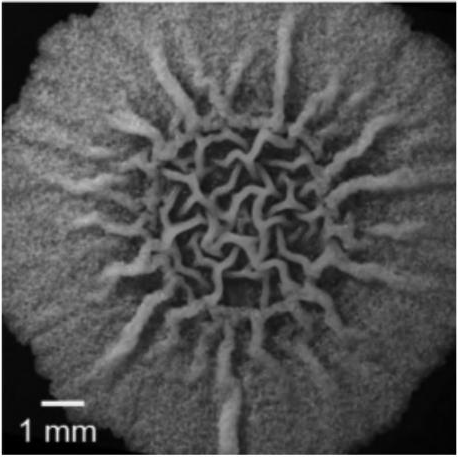A recent study published in the journal Cell Systems 1 uncovered that bacterial communities (biofilms) can store complex patterns of information through membrane potentials at the cellular level, in a similar way to neurons. But before we dive into the study’s findings, let us remember some bacterial biology. Figure 2. Bacillus subtilis biofilm growing on an agar dish. Image extracted from Gross et al (2020).
Figure 2. Bacillus subtilis biofilm growing on an agar dish. Image extracted from Gross et al (2020).
 Figure 2. Bacillus subtilis biofilm growing on an agar dish. Image extracted from Gross et al (2020).
Figure 2. Bacillus subtilis biofilm growing on an agar dish. Image extracted from Gross et al (2020).Biofilms and bacterial communication
Commonly, bacteria are represented as single cells that swim or float alone in a liquid medium, however, bacteria can behave as a community, and they often do so. Biofilms are formed once bacterial cells stick to one another, and while excreting the products of their metabolism, those become the extracellular matrix on which they establish and thrive, growing in huge numbers.
Bacteria in biofilms engage in distinct behaviours that were not evident in the past, when studies examined bacterial behaviour in low-density liquid cultures. The cells in bacterial communities show cooperative interactions that enhance collective survival 2. The structure of a biofilm as it is visible to the naked eye (figure 2) shows very intriguing features, like the way they grow into massive structured communities. In order to begin to understand how such organized communities are generated, we must examine the best characterized mechanism of bacterial communication: quorum sensing.
Quorum sensing (QS) aids bacteria in their transition to a community lifestyle. This system involves two components: a receptor in the surface of the bacteria capable of detecting the presence of a molecule, and a regulator of transcriptional response, which changes the amount or kind of proteins the bacterial cell produces for functioning 3. Since bacteria release molecules to the medium, these molecules can be detected by specific membrane receptors, allowing the bacteria to respond in specific ways to different molecules in the environment. QS is involved in many bacterial responses, such as antibiotic resistance, bioluminescence, or even the production of the necessary components to produce or maintain the molecular matrix of a biofilm4, therefore contributing to its appearance.
A key feature of quorum sensing is that the bacterial response is dependent of a threshold, so that when the extracellular concentration of a particular molecule reaches certain threshold is when the cells will respond. QS is therefore often promoting behavioural synchronicity in the population, so that a collective response is simultaneously generated in order to enhance virulence when the bacterial numbers are high, for example...
...
Memory encoding in bacterial communities
In this new study, the authors discovered that biofilms can store complex patterns of information. The researchers were aware that bacteria experience membrane potential spikes 7, and since other organisms have been found to experience changes in membrane potential upon exposure to blue light 8, they decided to test whether exposure to blue light could alter the membrane potential in biofilms of the bacteria Bacillus subtilis.
In order to test this, the authors studied a biofilm in conjunction with a special dye that reports differences in membrane potential by emitting fluorescence, and when areas of the biofilm were exposed to blue light these areas showed fluorescence indicating depolarization. Strikingly, the spatial pattern indicating a difference in membrane potential in the exposed area was persistent for periods of over 3 hours, implying that the biofilms can store patterns of spatial information in a membrane-potential-based memory, reminiscent of neurons. The biofilms can resolve fine details.
Author: María Girbés Mínguez is a doctoral student at Center for Molecular Neurobiology Hamburg (ZMNH) / UKE (University Medical Center Hamburg-Eppendorf)